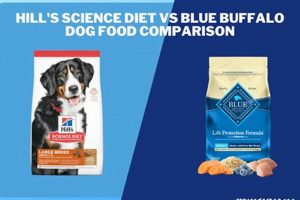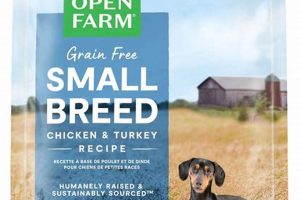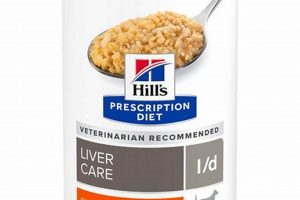Specialized canine diets formulated for breeds commonly referred to as “bully breeds” (e.g., American Pit Bull Terriers, American Bulldogs, Bull Terriers, American Staffordshire Terriers) are designed to support their unique physiological needs. These formulations typically consider the breed’s propensity for high muscle mass, energy requirements, and potential sensitivities. An example would be a high-protein, moderate-fat kibble with added joint support supplements.
The selection of appropriate nutrition for these canines is crucial for maintaining optimal health and well-being. Due to their muscular build and activity levels, these breeds often require diets richer in protein to support muscle maintenance and growth. A balanced ratio of macronutrients, coupled with essential vitamins and minerals, contributes to a healthy coat, strong bones, and overall vitality. Historically, appropriate nutrition for working dogs, including those with similar physical characteristics, was often overlooked, leading to potential health issues and decreased performance.
Understanding the specific nutritional demands of these powerful breeds allows for informed choices regarding their dietary management. The subsequent sections will delve into protein sources, fat content, carbohydrate considerations, and specific ingredient inclusions beneficial for these canine companions, as well as potential sensitivities and allergy management through dietary adjustments.
Nutritional Guidelines for Bully Breeds
This section offers essential guidance for the appropriate nutritional management of bully breed dogs, emphasizing health, performance, and longevity.
Tip 1: Prioritize High-Quality Protein Sources: Diets for bully breeds should primarily feature animal-based protein sources like chicken, beef, or fish. Protein is crucial for muscle development, repair, and overall bodily functions. Aim for a minimum protein content of 30% on a dry matter basis.
Tip 2: Moderate Fat Intake for Energy: Healthy fats are vital for energy and nutrient absorption. Opt for sources like fish oil, flaxseed oil, or chicken fat. Monitor body condition and adjust fat intake to prevent obesity or maintain energy levels.
Tip 3: Carbohydrate Inclusion with Consideration: While not the primary energy source, carbohydrates provide essential fiber and energy. Choose digestible sources like brown rice, sweet potatoes, or oats. Avoid excessive amounts of fillers like corn, wheat, and soy.
Tip 4: Supplementation for Joint Health: Bully breeds are prone to joint issues. Consider supplementing with glucosamine and chondroitin to support cartilage health and reduce inflammation. Consult a veterinarian for appropriate dosages.
Tip 5: Controlled Calcium and Phosphorus Levels: Maintaining proper calcium and phosphorus ratios is critical for bone development, especially in puppies. Excess supplementation can be detrimental. Choose diets specifically formulated for large breed puppies or consult a veterinary nutritionist.
Tip 6: Monitor for Allergies and Sensitivities: Some bully breeds exhibit sensitivities to certain ingredients. Observe for signs like skin irritation, digestive upset, or excessive scratching. Eliminate potential allergens through an elimination diet guided by a veterinarian.
Tip 7: Regular Weight Monitoring and Adjustments: Regularly assess body condition using a body condition score chart. Adjust food portions based on activity level, age, and individual metabolism to maintain a healthy weight.
These guidelines enable responsible pet owners to make informed decisions regarding their bully breed’s nutrition, contributing to their overall health, vitality, and longevity.
The following section will provide a comprehensive breakdown of the ingredients to watch out for in manufactured canine diets.
1. High-protein Formulation
The correlation between high-protein formulations and canine diets specifically designed for bully breeds stems from the inherent physiological characteristics of these dogs. Bully breeds, such as American Pit Bull Terriers, American Bulldogs, and similar breeds, typically exhibit substantial muscle mass and a propensity for high activity levels. This necessitates a diet rich in protein to support muscle maintenance, repair, and growth. Insufficient protein intake can lead to muscle atrophy, decreased energy levels, and impaired overall health. For example, a working American Bulldog expending significant energy requires a substantially higher protein intake than a less active breed.
The importance of high-protein formulations in bully breed dog food extends beyond mere muscle maintenance. Protein provides essential amino acids, the building blocks of various bodily tissues and enzymes, crucial for numerous metabolic processes. Moreover, diets rich in animal-based protein sources often provide enhanced palatability, encouraging sufficient food intake. Consider a scenario where a picky eater within a bully breed lineage benefits from a high-protein, meat-based formula, resolving prior issues of inadequate caloric consumption and promoting optimal growth.
In summary, the incorporation of high-protein formulations into canine diets tailored for bully breeds is a fundamental requirement dictated by their muscular build and energetic nature. Understanding this connection empowers owners to make informed dietary choices, promoting the health, performance, and longevity of their canine companions. Failure to provide adequate protein levels can lead to detrimental health outcomes. The formulation of appropriate bully breed dog food necessitates careful consideration of protein sources and overall macronutrient ratios.
2. Joint Support Supplements
The inclusion of joint support supplements in formulations designed as “bully breed dog food” directly addresses the predisposition of many bully breeds to develop joint-related ailments, such as hip and elbow dysplasia and arthritis. These conditions can significantly impact the canine’s mobility, comfort, and overall quality of life. Joint support supplements, commonly glucosamine and chondroitin sulfate, provide the building blocks for cartilage repair and maintenance, mitigating the effects of joint degradation. Their strategic incorporation into specialized diets serves as a preventative measure and a therapeutic aid.
The practical significance of incorporating joint support supplements into “bully breed dog food” is evident in the observed reduction of lameness and pain in affected animals. For instance, a senior American Bulldog, consistently fed a diet enriched with glucosamine and chondroitin, may experience a noticeable improvement in mobility compared to a dog of similar age and breed receiving a standard maintenance diet. Furthermore, the presence of these supplements can minimize the reliance on non-steroidal anti-inflammatory drugs (NSAIDs), reducing the potential for associated side effects. These supplements may also offer benefit to dogs that participate in high-impact activities.
Therefore, the strategic addition of joint support supplements in bully breed-specific diets is a responsible and proactive approach to canine care. It addresses a known vulnerability within these breeds and offers demonstrable benefits in terms of joint health and mobility. The careful selection of high-quality supplements, combined with a balanced diet, contributes significantly to the long-term well-being of bully breed dogs. While supplements can be beneficial, it’s important to consult with a veterinarian to ensure appropriate dosage and suitability for each individual dog.
3. Digestible Carbohydrates
The inclusion of digestible carbohydrates in specialized “bully breed dog food” formulations serves a critical role in providing readily available energy and essential fiber. Unlike simple sugars, which can cause rapid blood glucose spikes, digestible carbohydrates are metabolized more slowly, offering a sustained energy source necessary for the high activity levels often exhibited by bully breeds. The selection of carbohydrate sources directly impacts nutrient absorption and overall digestive health. Inappropriate or poorly digestible carbohydrates can lead to gastrointestinal distress, including bloating, diarrhea, and nutrient malabsorption, hindering the breed’s ability to thrive.
Examples of suitable digestible carbohydrate sources often incorporated into “bully breed dog food” include sweet potatoes, brown rice, and oats. These ingredients are typically well-tolerated and offer a balance of complex carbohydrates and dietary fiber. Fiber, in particular, contributes to healthy bowel movements and can aid in weight management by promoting a feeling of satiety. Contrastingly, corn, wheat, and soy, often used as inexpensive fillers, are less digestible for many dogs and can trigger allergic reactions or sensitivities in some bully breeds, leading to skin issues or digestive upset. The importance of selecting appropriate carbohydrates is underscored by cases where switching to a diet with easily digestible carbohydrates resolves chronic gastrointestinal problems in sensitive individuals.
In summary, the strategic selection of digestible carbohydrates is an important component of a well-formulated “bully breed dog food.” The goal is to provide sustained energy, promote digestive health, and minimize the risk of adverse reactions. While protein remains a primary focus, the carbohydrate component should not be overlooked. Proper carbohydrate management contributes significantly to the overall health and well-being of these breeds. Therefore, careful consideration of carbohydrate sources is a key aspect of responsible feeding practices.
4. Limited Grain Inclusion
The concept of limited grain inclusion in “bully breed dog food” formulations reflects a growing understanding of canine nutritional sensitivities and the potential impact of grains on digestive health and allergic reactions. While grains can provide carbohydrates, their inclusion in dog food, particularly in excessive amounts, has raised concerns among owners and veterinarians regarding their digestibility and allergenic potential in certain breeds.
- Reduced Allergen Exposure
Limiting grain content can minimize exposure to common allergens found in grains like wheat, corn, and soy. These allergens can trigger skin irritations, digestive upset, and other allergic reactions in susceptible dogs. By reducing or eliminating these grains, the likelihood of adverse reactions is diminished, leading to improved overall health and comfort. Consider the scenario where a bully breed, previously experiencing chronic skin issues, exhibits marked improvement upon switching to a grain-limited diet.
- Improved Digestibility
Grains, especially when not properly processed, can be difficult for some dogs to digest. This can result in inefficient nutrient absorption and gastrointestinal discomfort. Limiting grain content often involves replacing these with more digestible carbohydrate sources like sweet potatoes or peas. These alternatives offer a more readily available energy source and reduce the burden on the digestive system, particularly beneficial for breeds prone to digestive sensitivities.
- Control over Carbohydrate Sources
Limiting grains allows for greater control over the types of carbohydrates included in the diet. This enables manufacturers to select nutrient-dense and fiber-rich carbohydrate sources that contribute to overall health. This control ensures that the carbohydrates included provide a more balanced and beneficial nutritional profile compared to relying solely on grains as a primary carbohydrate source. Furthermore, it enables customization of carbohydrate levels based on the breed’s activity level and metabolic needs.
- Focus on Protein and Fat Sources
With reduced reliance on grains, “bully breed dog food” formulations can emphasize animal-based protein and healthy fat sources. These macronutrients are crucial for muscle development, energy production, and overall well-being in these breeds. A focus on protein and fat aligns with the nutritional requirements of bully breeds, supporting their active lifestyles and muscular physique. Shifting away from grain-heavy diets allows for a more protein-rich and fat-balanced nutritional profile, potentially leading to improved muscle mass, energy levels, and coat condition.
These factors demonstrate the rationale behind limiting grain inclusion in “bully breed dog food”. The intention is to create a diet that minimizes allergenic potential, enhances digestibility, provides superior carbohydrate sources, and allows for a greater emphasis on protein and fat content. This approach aligns with the unique nutritional needs of bully breeds, contributing to their long-term health and vitality. It is worth noting that the term “grain-free” is not synonymous with “low carbohydrate,” and the overall carbohydrate content should still be considered.
5. Omega Fatty Acids
The strategic inclusion of omega fatty acids in “bully breed dog food” addresses several critical aspects of canine health, specifically those pertaining to inflammatory response, skin and coat condition, and cardiovascular function. Omega-3 and omega-6 fatty acids, essential fatty acids that dogs cannot synthesize endogenously, must be obtained through dietary sources. A balanced ratio of these fatty acids is paramount for optimal physiological function. Imbalances, particularly an excess of omega-6 fatty acids without sufficient omega-3, can exacerbate inflammatory conditions. Bully breeds, potentially predisposed to skin allergies and joint issues, may benefit substantially from a diet thoughtfully enriched with omega fatty acids. Consider the case of a bully breed with chronic atopic dermatitis exhibiting reduced pruritus and improved skin barrier function following a dietary shift to a formulation with elevated omega-3 fatty acid content.
The practical implications of this connection extend beyond alleviating skin conditions. Omega-3 fatty acids, notably EPA (eicosapentaenoic acid) and DHA (docosahexaenoic acid), possess anti-inflammatory properties that can positively influence joint health, mitigating the progression of arthritis and improving mobility. Furthermore, these fatty acids contribute to cardiovascular health by reducing triglyceride levels and supporting healthy blood pressure. Examples of suitable omega fatty acid sources in “bully breed dog food” include fish oil, flaxseed oil, and algal oil. The selection of appropriate sources and ratios is crucial for achieving the desired therapeutic effects. For example, a senior bully breed with early-stage osteoarthritis may experience improved comfort and mobility when fed a diet rich in EPA and DHA derived from fish oil.
In summary, the integration of omega fatty acids into “bully breed dog food” is a deliberate strategy to address inflammation, promote skin and coat health, and support cardiovascular function. Understanding the nuances of omega-3 and omega-6 ratios, coupled with the judicious selection of fatty acid sources, is essential for maximizing the benefits of this dietary component. While omega fatty acids offer significant advantages, it is important to consider potential challenges, such as oxidation of unsaturated fats, and to ensure proper storage and handling of the food to maintain its nutritional integrity. The responsible incorporation of omega fatty acids into “bully breed dog food” constitutes a proactive measure to enhance overall well-being and longevity.
6. Controlled Calcium Levels
The precise regulation of calcium levels in “bully breed dog food” is paramount, particularly during the crucial growth phase of these canines. Bully breeds, known for their rapid development and substantial bone structure, are highly susceptible to skeletal abnormalities if calcium intake is not carefully managed. Excessive calcium consumption can lead to developmental orthopedic diseases such as hip dysplasia, elbow dysplasia, and osteochondrosis dissecans (OCD). These conditions can cause significant pain, lameness, and reduced quality of life. Consequently, the design of specialized diets for bully breeds necessitates meticulous attention to calcium content and its ratio to phosphorus. For example, a large-breed puppy food specifically formulated for bully breeds will typically have a lower calcium concentration compared to general puppy food, mitigating the risk of accelerated bone growth and subsequent skeletal issues.
The practical implications of controlled calcium levels are evident in the observed reduction of skeletal abnormalities in bully breeds raised on appropriately formulated diets. Conversely, over-supplementation with calcium, often driven by misconceptions about promoting bone strength, can have detrimental consequences. A case study involving a litter of American Bulldogs fed a diet with excessive calcium supplementation revealed a higher incidence of hip dysplasia compared to a control group receiving a balanced diet. Moreover, the calcium-to-phosphorus ratio is equally crucial. An imbalance can interfere with calcium absorption and utilization, further increasing the risk of skeletal problems. The ideal ratio typically falls between 1:1 and 2:1, ensuring proper bone mineralization. Routine veterinary check-ups and monitoring of growth rates are essential to adjust dietary calcium levels as needed, taking into account individual breed variations and growth patterns.
In summary, maintaining controlled calcium levels in “bully breed dog food” is not merely a nutritional detail but a critical factor in preventing debilitating skeletal diseases. The potential for skeletal abnormalities in these breeds underscores the importance of selecting commercially available diets specifically formulated for large-breed puppies or consulting with a veterinary nutritionist to ensure appropriate calcium intake. Failure to adhere to these guidelines can result in irreversible damage to the skeletal system, impacting the long-term health and well-being of these dogs. Therefore, responsible ownership includes a commitment to providing balanced nutrition, with particular emphasis on controlled calcium levels, during the critical growth stages of bully breeds.
7. L-Carnitine Additives
The inclusion of L-Carnitine as an additive in formulations designed as “bully breed dog food” is linked to its role in fatty acid metabolism and energy production. L-Carnitine facilitates the transport of long-chain fatty acids into the mitochondria, the cellular power plants, where they are oxidized to generate energy. Bully breeds, often characterized by significant muscle mass and high activity levels, can benefit from enhanced fatty acid utilization to support energy demands and maintain lean body composition. Its incorporation into canine diets is predicated on the theory that increased L-Carnitine availability promotes efficient fat burning, thereby aiding in weight management and supporting muscle development. For example, a working American Pit Bull Terrier expending substantial energy daily could theoretically benefit from increased fat oxidation facilitated by L-Carnitine supplementation.
The potential benefits of L-Carnitine supplementation in “bully breed dog food” extend beyond energy production. Studies suggest it may also play a role in reducing muscle fatigue and improving exercise performance. Furthermore, L-Carnitine has been investigated for its potential cardioprotective effects, particularly in breeds predisposed to certain cardiac conditions. Consider the scenario of a sedentary bully breed prone to obesity; L-Carnitine supplementation, coupled with appropriate diet and exercise, may contribute to weight loss and improved cardiovascular health. However, the efficacy of L-Carnitine supplementation is contingent upon various factors, including dosage, bioavailability, and individual metabolic responses. A definitive conclusion on the universal benefits of L-Carnitine in all bully breeds requires further research.
In summary, the rationale for including L-Carnitine additives in “bully breed dog food” rests on its potential to enhance fatty acid metabolism, support energy production, and contribute to weight management and cardiovascular health. While the benefits are theoretically sound and supported by some research, the effectiveness of L-Carnitine supplementation may vary depending on individual animal characteristics and dietary context. Challenges remain in determining optimal L-Carnitine dosages and assessing long-term effects. Nonetheless, the strategic addition of L-Carnitine reflects a growing understanding of the nuanced nutritional needs of bully breeds and a proactive approach to promoting their overall well-being. The careful consideration of L-Carnitine in “bully breed dog food” formulation underscores a commitment to addressing the unique physiological demands of these canines.
Frequently Asked Questions
This section addresses common inquiries concerning the specialized nutritional requirements of breeds commonly referred to as “bully breeds,” focusing on dietary considerations for optimal health.
Question 1: What differentiates “bully breed dog food” from standard canine diets?
Formulations marketed as “bully breed dog food” typically feature higher protein content, often sourced from animal-based proteins. They may also include specific additives, such as joint support supplements, and controlled levels of calcium and phosphorus to address breed-specific health concerns.
Question 2: Are grain-free diets always superior for bully breeds?
Grain-free diets are not inherently superior. While some bully breeds exhibit sensitivities to certain grains, the exclusion of grains should be based on individual dietary needs and potential allergies. A balanced diet, whether grain-inclusive or grain-free, is essential.
Question 3: How does protein content influence the health of bully breeds?
Protein is crucial for muscle development, repair, and overall bodily functions. Given the muscular build of many bully breeds, a higher protein intake supports muscle maintenance and growth. However, protein levels should be balanced within a complete and balanced diet.
Question 4: Why is calcium regulation important in “bully breed dog food?”
Controlled calcium levels, particularly during puppyhood, are vital to prevent skeletal abnormalities. Excessive calcium can disrupt bone development and increase the risk of hip and elbow dysplasia. Appropriate calcium-to-phosphorus ratios are crucial.
Question 5: Is supplementation necessary when feeding “bully breed dog food?”
While high-quality “bully breed dog food” often contains essential nutrients, individual needs may vary. Supplementation, such as joint support supplements, may be beneficial but should be determined in consultation with a veterinarian.
Question 6: How can potential food sensitivities be identified in bully breeds?
Food sensitivities can manifest as skin irritation, digestive upset, or chronic ear infections. Suspected sensitivities can be investigated through an elimination diet, under the guidance of a veterinarian, to identify potential allergenic ingredients.
In summary, specialized nutrition for bully breeds necessitates careful consideration of protein content, carbohydrate sources, mineral balance, and potential sensitivities. Consulting a veterinary professional is advisable for tailoring dietary choices to individual needs.
The subsequent section explores various canine health considerations relevant to dietary choices.
The Importance of Understanding “Bully Breed Dog Food”
This exploration of “bully breed dog food” has underscored the critical need for tailored nutritional strategies specific to these powerful canines. It has highlighted the significance of high-quality protein, appropriate carbohydrate sources, strategic supplementation, and meticulous mineral balance. These dietary considerations directly impact musculoskeletal health, digestive function, and overall vitality within this breed category.
The information presented herein serves as a foundation for informed decision-making. Continued research and veterinary consultation remain essential for refining nutritional protocols and optimizing the long-term health and well-being of these deserving animals. The responsible selection and implementation of appropriate dietary practices represent a significant investment in their quality of life.






![Evolve Dog Food: Is It Really Good? [Review] World’s Most Delicious Foods: Must-Try Dishes from Every Country Evolve Dog Food: Is It Really Good? [Review] | World’s Most Delicious Foods: Must-Try Dishes from Every Country](https://lisasfoods.com/wp-content/uploads/2025/12/th-714-300x200.jpg)
